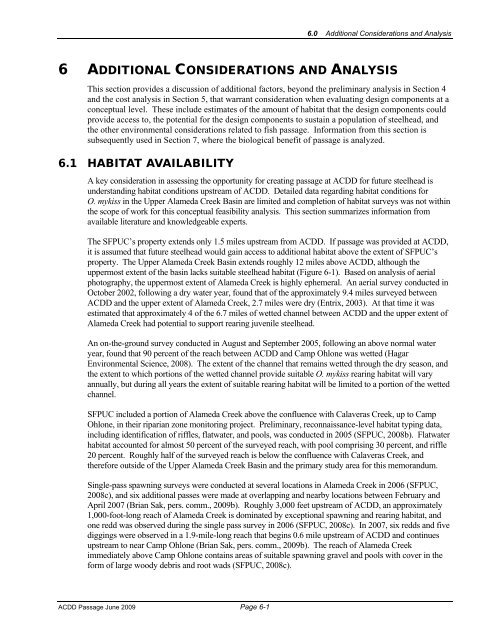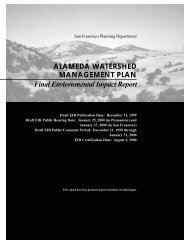Feasibility of Fish Passage at Alameda Creek Diversion Dam
Feasibility of Fish Passage at Alameda Creek Diversion Dam
Feasibility of Fish Passage at Alameda Creek Diversion Dam
Create successful ePaper yourself
Turn your PDF publications into a flip-book with our unique Google optimized e-Paper software.
6.0 Additional Consider<strong>at</strong>ions and Analysis6 ADDITIONAL CONSIDERATIONS AND ANALYSISThis section provides a discussion <strong>of</strong> additional factors, beyond the preliminary analysis in Section 4and the cost analysis in Section 5, th<strong>at</strong> warrant consider<strong>at</strong>ion when evalu<strong>at</strong>ing design components <strong>at</strong> aconceptual level. These include estim<strong>at</strong>es <strong>of</strong> the amount <strong>of</strong> habit<strong>at</strong> th<strong>at</strong> the design components couldprovide access to, the potential for the design components to sustain a popul<strong>at</strong>ion <strong>of</strong> steelhead, andthe other environmental consider<strong>at</strong>ions rel<strong>at</strong>ed to fish passage. Inform<strong>at</strong>ion from this section issubsequently used in Section 7, where the biological benefit <strong>of</strong> passage is analyzed.6.1 HABITAT AVAILABILITYA key consider<strong>at</strong>ion in assessing the opportunity for cre<strong>at</strong>ing passage <strong>at</strong> ACDD for future steelhead isunderstanding habit<strong>at</strong> conditions upstream <strong>of</strong> ACDD. Detailed d<strong>at</strong>a regarding habit<strong>at</strong> conditions forO. mykiss in the Upper <strong>Alameda</strong> <strong>Creek</strong> Basin are limited and completion <strong>of</strong> habit<strong>at</strong> surveys was not withinthe scope <strong>of</strong> work for this conceptual feasibility analysis. This section summarizes inform<strong>at</strong>ion fromavailable liter<strong>at</strong>ure and knowledgeable experts.The SFPUC’s property extends only 1.5 miles upstream from ACDD. If passage was provided <strong>at</strong> ACDD,it is assumed th<strong>at</strong> future steelhead would gain access to additional habit<strong>at</strong> above the extent <strong>of</strong> SFPUC’sproperty. The Upper <strong>Alameda</strong> <strong>Creek</strong> Basin extends roughly 12 miles above ACDD, although theuppermost extent <strong>of</strong> the basin lacks suitable steelhead habit<strong>at</strong> (Figure 6-1). Based on analysis <strong>of</strong> aerialphotography, the uppermost extent <strong>of</strong> <strong>Alameda</strong> <strong>Creek</strong> is highly ephemeral. An aerial survey conducted inOctober 2002, following a dry w<strong>at</strong>er year, found th<strong>at</strong> <strong>of</strong> the approxim<strong>at</strong>ely 9.4 miles surveyed betweenACDD and the upper extent <strong>of</strong> <strong>Alameda</strong> <strong>Creek</strong>, 2.7 miles were dry (Entrix, 2003). At th<strong>at</strong> time it wasestim<strong>at</strong>ed th<strong>at</strong> approxim<strong>at</strong>ely 4 <strong>of</strong> the 6.7 miles <strong>of</strong> wetted channel between ACDD and the upper extent <strong>of</strong><strong>Alameda</strong> <strong>Creek</strong> had potential to support rearing juvenile steelhead.An on-the-ground survey conducted in August and September 2005, following an above normal w<strong>at</strong>eryear, found th<strong>at</strong> 90 percent <strong>of</strong> the reach between ACDD and Camp Ohlone was wetted (HagarEnvironmental Science, 2008). The extent <strong>of</strong> the channel th<strong>at</strong> remains wetted through the dry season, andthe extent to which portions <strong>of</strong> the wetted channel provide suitable O. mykiss rearing habit<strong>at</strong> will varyannually, but during all years the extent <strong>of</strong> suitable rearing habit<strong>at</strong> will be limited to a portion <strong>of</strong> the wettedchannel.SFPUC included a portion <strong>of</strong> <strong>Alameda</strong> <strong>Creek</strong> above the confluence with Calaveras <strong>Creek</strong>, up to CampOhlone, in their riparian zone monitoring project. Preliminary, reconnaissance-level habit<strong>at</strong> typing d<strong>at</strong>a,including identific<strong>at</strong>ion <strong>of</strong> riffles, fl<strong>at</strong>w<strong>at</strong>er, and pools, was conducted in 2005 (SFPUC, 2008b). Fl<strong>at</strong>w<strong>at</strong>erhabit<strong>at</strong> accounted for almost 50 percent <strong>of</strong> the surveyed reach, with pool comprising 30 percent, and riffle20 percent. Roughly half <strong>of</strong> the surveyed reach is below the confluence with Calaveras <strong>Creek</strong>, andtherefore outside <strong>of</strong> the Upper <strong>Alameda</strong> <strong>Creek</strong> Basin and the primary study area for this memorandum.Single-pass spawning surveys were conducted <strong>at</strong> several loc<strong>at</strong>ions in <strong>Alameda</strong> <strong>Creek</strong> in 2006 (SFPUC,2008c), and six additional passes were made <strong>at</strong> overlapping and nearby loc<strong>at</strong>ions between February andApril 2007 (Brian Sak, pers. comm., 2009b). Roughly 3,000 feet upstream <strong>of</strong> ACDD, an approxim<strong>at</strong>ely1,000-foot-long reach <strong>of</strong> <strong>Alameda</strong> <strong>Creek</strong> is domin<strong>at</strong>ed by exceptional spawning and rearing habit<strong>at</strong>, andone redd was observed during the single pass survey in 2006 (SFPUC, 2008c). In 2007, six redds and fivediggings were observed in a 1.9-mile-long reach th<strong>at</strong> begins 0.6 mile upstream <strong>of</strong> ACDD and continuesupstream to near Camp Ohlone (Brian Sak, pers. comm., 2009b). The reach <strong>of</strong> <strong>Alameda</strong> <strong>Creek</strong>immedi<strong>at</strong>ely above Camp Ohlone contains areas <strong>of</strong> suitable spawning gravel and pools with cover in theform <strong>of</strong> large woody debris and root wads (SFPUC, 2008c).ACDD <strong>Passage</strong> June 2009 Page 6-1








